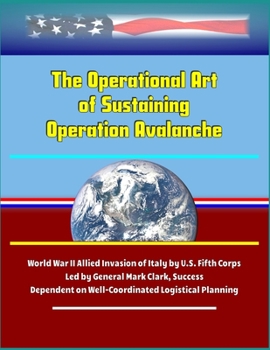The Operational Art of Sustaining Operation Avalanche - World War II Allied Invasion of Italy by U.S. Fifth Corps Led by General Mark Clark, Success D
In early October 1943, General Dwight D. Eisenhower surveyed the destruction left behind in Naples, Italy, by the retreating German army. Despite the destruction, the Allies secured the port and successfully began the buildup of men, equipment, and material to continue combat operations in Italy. The Fifth Army achieved Operation Avalanche's objective to secure basing in Italy for further operations. The success of combat operations during Operation Avalanche depended on well-coordinated logistical planning and execution. U.S. and British logistic planners supported an emerging strategy in the Mediterranean by anticipating requirements and linking strategic resources to tactical consumption. Using the lens of operational art provides clarity as to how logisticians supported large-scale combat operations in a contested environment. The elements of operational art and principles of sustainment are tools to help understand the development of Operation Avalanche as the Allies' strategy evolved in the Mediterranean.This compilation also includes a reproduction of the 2019 Worldwide Threat Assessment of the U.S. Intelligence Community.Contents: 1. Introduction * 2. Historiography * 3. Strategic Setting: Casablanca to Trident Conferences * 4. Operational Planning: Expanding the Mediterranean Theater * 5. Operation Avalanche * 6. ConclusionOperation Avalanche emerged out of negotiations by Allied leadership to exploit opportunities following Operation Torch against the Axis in the Mediterranean. In January of 1943, the Allies lacked a cohesive strategy to prosecute the war in Europe and the Pacific. The Casablanca Conference began a series of high-level meetings in 1943 between U.S. President Franklin Delano Roosevelt and United Kingdom Prime Minister Winston Churchill, and their respective military advisors. Roosevelt and Churchill agreed to a "Europe First" strategy but did not agree on the best way to prosecute the war in Europe. Churchill and the British military leadership advocated for a peripheral strategy. This approach called for expanded military operations in the Mediterranean to attack Germany's southern flank in Italy and the Balkans. The British believed the strategy created several strategic security dilemmas for Germany by making its allies, lines of communication, and resources vulnerable to attack. The plan sought to minimize British causalities and still force Germany to overextend its limited resources by defending multiple fronts. The cumulative effects would reduce German pressure on the Soviet Union and the ability to defend northern France from a future Allied attack.
Format:Paperback
Language:English
ISBN:1699214492
ISBN13:9781699214497
Release Date:January 1
Publisher:Independently Published
Length:74 Pages
Weight:0.43 lbs.
Dimensions:0.1" x 8.5" x 11.0"
Related Subjects
HistoryCustomer Reviews
0 rating





